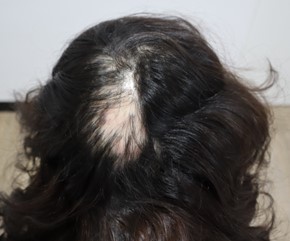Lichen Planopilaris (LPP)
What is Lichen Planopilaris?
- Lichen Planopilaris is a relatively uncommon inflammatory disorder that leads to permanent hair loss. It is categorised as scarring alopecia.
- It is considered to be a variant of the skin condition lichen planus that impacts the hair follicles.
- It typically affects women, although some men are affected too.
- The cause is unknown but it is believed to be an autoimmune response to an unknown antigen in hair follicles.
What are the symptoms of Lichen Planopilaris?
- Itchiness
- A burning sensation
- Hair fall
- Tenderness,scaling and redness of the scalp
- Sometimes there are no symptoms, but just smooth white patches of hair loss on the scalp.
- No hair follicle openings can be seen in the areas of hair loss
- Scale and redness surround each hair follicle.
- During the inflammatory and active phase, these symptoms are more prominent.
- In some cases, patients may experience loss of eyebrows and body hair.
- Although these patients can live long healthy lives, and it is not considered physically serious, the condition is extremely psychologically distressing for many women and men.
- Untreated itch and burn can be highly frustrating too.
How is Lichen Planopilaris diagnosed at Aurora Dermatology?
- At Aurora Dermatology your visit begins with our caring nurse who measures blood pressure and takes photos.
- Subsequently, Dr Parisa will review your history, examine your scalp and conduct specialised tests such as hair pull test, trichoscopy before commencement of your treatment plan.
- This comprehensive full history, and thorough physical examination are pivotal for making a diagnosis,with biopsies rarely necessary.
- Dr Parisa also captures both before and after photos to monitor disease progression and track improvements in her patients over time.
- This practice aids in assessing the effectiveness of the treatment.
What is the treatment for Lichen Planopilaris?
- As there is no treatment for hairs that have already been lost and replaced by scarring, diagnosis and treatment should start as early as possible with the aim to slow the onset of the disease, relieve symptoms and to save the unaffected hair on the rest of the scalp.
- Dr Parisa administers intralesional steroid injections every four weeks when the disease is active to treat dermal inflammation.
- During the procedure, she uses a small sized needle and a vibration device to minimize discomfort for patients.
- Topical treatments such as corticosteroids, topical tacrolimus, topical Minoxidil may be prescribed.
- Oral treatments such as antibiotics (doxycycline, minocycline), Acitretin (an oral retinoid) and Methotrexate (an immune system suppressant and chemotherapy agent), Hydroxychloroquine, (an anti-malarial) oral pioglitazone or finasteride, dutasteride may be prescribed to slow down the hair loss
- Platelet Rich Plasma injections into the scalp can be used. This is where the patients own blood is spun through a centrifuge, platelets extracted and injected into the scalp.
Read more about PRP here. - Camouflage with wigs and careful hair styling are helpful options
- JAK inhibitors have shown some preliminary promise
- Biologic treatments such as TNF alpha inhibitors and lxekizumab (an autoimmune drug to reduce inflammation) is currently being trialled as an offlable treatment for lichen planopilaris
- Response to these treatments are quite variable and patients are often advised that the most they can hope for is to stop the progression of hair loss and minimise discomfort.
What can I do at home?
- Your scalp may be sensitive so ask your doctor or dermatologist to recommend or prescribe hypoallergenic shampoos and hair products.
- Avoid ingredients such as alcohol, essential oils, fragrance and perfumes and preservatives like parabens and methylisothiazolinone on your scalp.
- Ask about organisations that can improve self esteem through wigs, scarves or wig caps to protect your scalp and make your wig more comfortable.
What are the three types of lichen planopilaris?
- Classic lichen planopilaris causes scarring and bald patches on the scalp.
- Frontal fibrosing alopecia causes bald patches and scarring at the hairline near the forehead. There may also be hair loss in the eyebrows.
- Graham Little Piccardi Syndrome causes scarring and bald patches on the scalp, as well as thinning hair in the armpits and groin and rough bumps around the hair follicles.
“Remember lichen planopilaris is a scarring disease. This means if hair is lost, it may not regrow and initiating early treatment can help preserve and save the unaffected hair on the rest of the scalp. Regular and ongoing monitoring is important.”
Disclaimer. Individual results may vary. All procedures have risks. Discuss your symptoms with your doctor.
References
Lichen Planopilaris Cleveland Clinic



